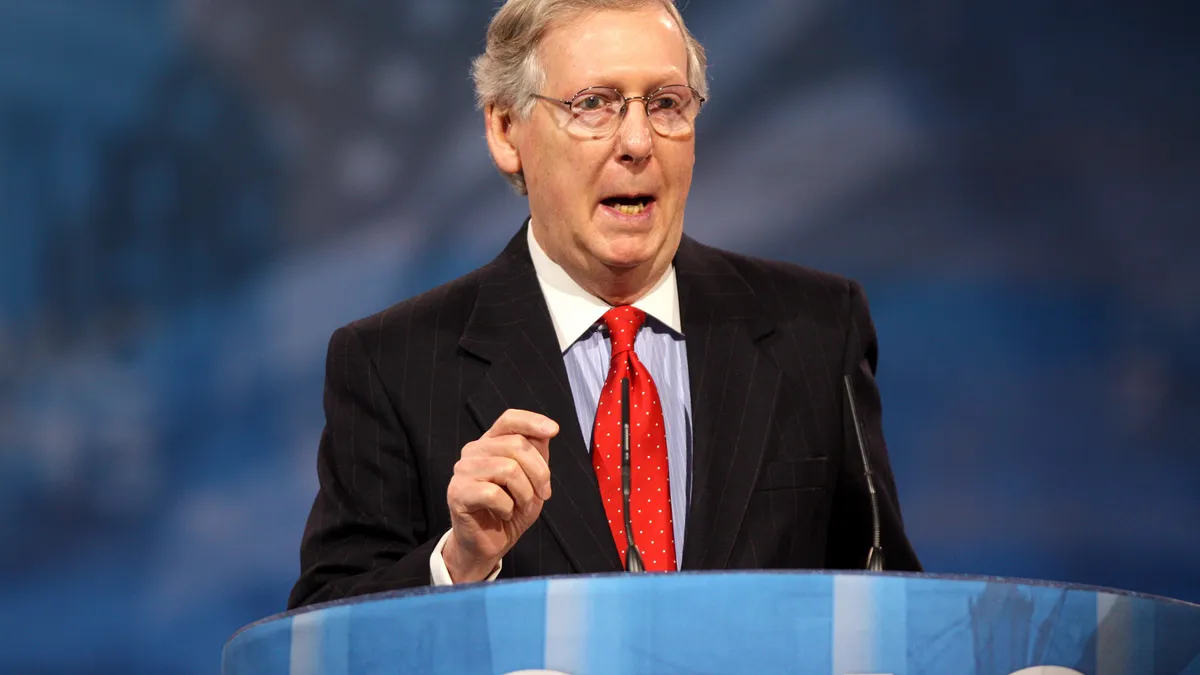UPDATE: March 27, 2020: President Donald Trump signed the CARES Act into law Friday, shortly after the House of Representatives approved the historic $2 trillion stimulus package.
The Coronavirus Aid, Relief and Economic Security Act that passed 96-0 in the Senate late Wednesday night provides $30.75 billion in emergency relief funds for the U.S. Department of Education. Of that, approximately $13.5 billion would be used for K-12 emergency relief grants and an additional $3.5 billion would be reserved for governors to use and distribute based on local need.
Steny Hoyer, the House majority leader, said late Wednesday the House would consider the full stimulus bill Friday, and President Donald Trump said he would immediately sign the full package when it reaches his desk.
Under the Senate CARES Act, U.S. Secretary of Education Betsy DeVos would be required to approve and distribute the funds within a month of receiving state applications for funds.
States would have flexibility in how they use the funds, and possible areas of spending include, but are not limited to:
- Cleaning and disinfecting supplies.
- Purchasing 1:1 devices and internet service for students without laptops and WiFi access.
- Training and professional development.
- Addressing the unique needs of low-income students, those with disabilities, English learners, racial and ethnic minorities, students experiencing homelessness and foster care youth.
- Ensuring services like meals and special education continue during closures.
- Providing mental health services.
The final amount is part of a comprehensive stimulus package, but legislative analysts and education associations say the $13.5 billion is nowhere near enough for sustained support through what could be months of closures.
Analysts and advocates: Schools 'need a lot more help'
"While this is a first step forward, we need a lot more resources than what we’re currently getting," said Chip Slaven, chief advocacy officer for the National School Boards Association.
Education organizations, including the NSBA, had requested billions more in funding.
In 2009, the Obama administration passed the American Recovery and Reinvestment Act stimulus package following the 2008 economic crisis. That legislation included approximately $77 billion for schools, a "significantly larger amount of money" compared to the $13.5 billion that is in the CARES package. The $77 billion at the time was put to use even though students were still physically in school without the threat of a pandemic.
Now, with students at home during coronavirus-related closures and a complete shift in district operations, the need is greater, according to the NSBA. "Based on what we’re hearing and seeing, ultimately schools are going to need a lot more help than what’s in this current package," Slaven said.
Francisco Negron, NSBA’s chief legal officer, said this is especially true considering the whole gamut of services districts are mobilizing to offer through closures, including 1:1 devices, online instruction and a new meal distribution system.
Package structure cause for concern
An earlier U.S. House version of the bill included $2 billion in funding especially for the Federal Communications Commission's E-rate program. While this package includes flexibility in how states spend their funds — meaning they could technically spend it on 1:1 devices and hotspots if needed — it doesn't carve out an amount specifically for the telecommunications discount program.
Carving out those funds through E-rate would have ensured protections so the money is spent efficiently for students who don't have WiFi access or devices at home, said Noelle Ellerson Ng, associate executive director of policy and advocacy for AASA, The School Superintendents Association. Those protections "don't exist in this stabilization fund," she said.
"Vendors are going to see it as a slush fund and they are going to target state and education agencies claiming they have all the bells and whistles," Ellerson Ng added.
If lawmakers were "serious about getting their best return for investment," she said, they would have moved it through the E-rate program.
Another cause for alarm, Ellerson Ng pointed out, is a provision included in the bill that would allow the Education Department to waive the need for states to maintain support for schools at the same levels as previous years "for the purpose of relieving fiscal burdens on states that have experienced a precipitous decline in financial resources."
With a recession on the horizon, this language would allow states to cut back on education spending while funneling the federal dollars provided in the package to districts. Ultimately, this could mean districts would feel no net benefit and might even experience cuts instead.
"This sets up a scenario where states have room to adjust to the fiscal pressures of a recession, a flexibility not afforded to local education agencies," Ellerson Ng said.
Across the board, many education organizations agree additional funds will be necessary in the coming weeks. Marguerite Roza, director of the Edunomics Lab at Georgetown University in Washington, D.C., suggested additional stimulus packages could be on the horizon.
"We do have some time," she said.




















